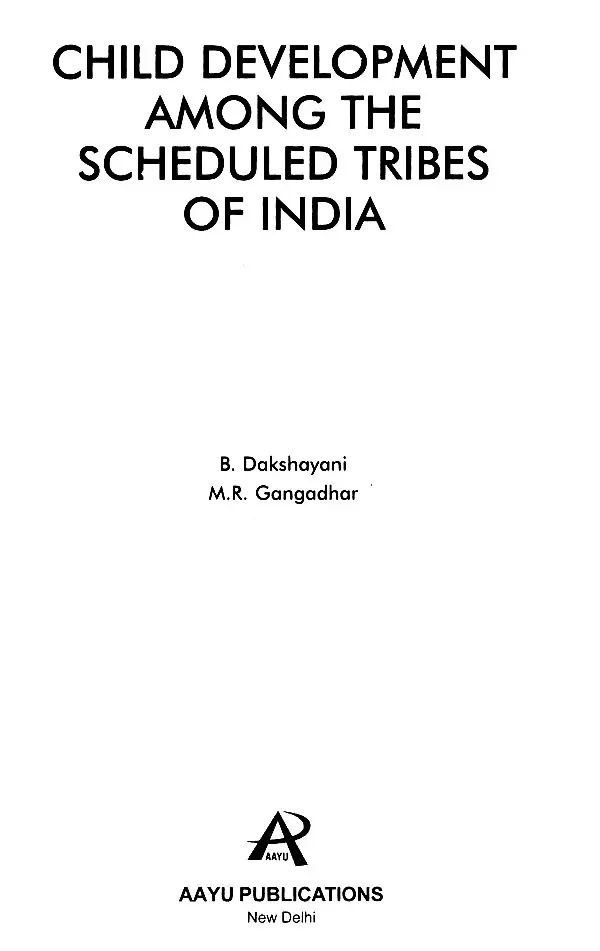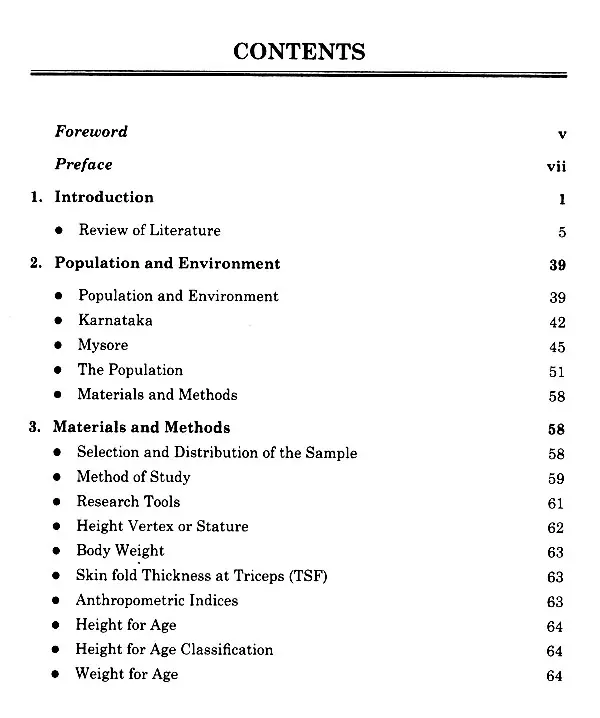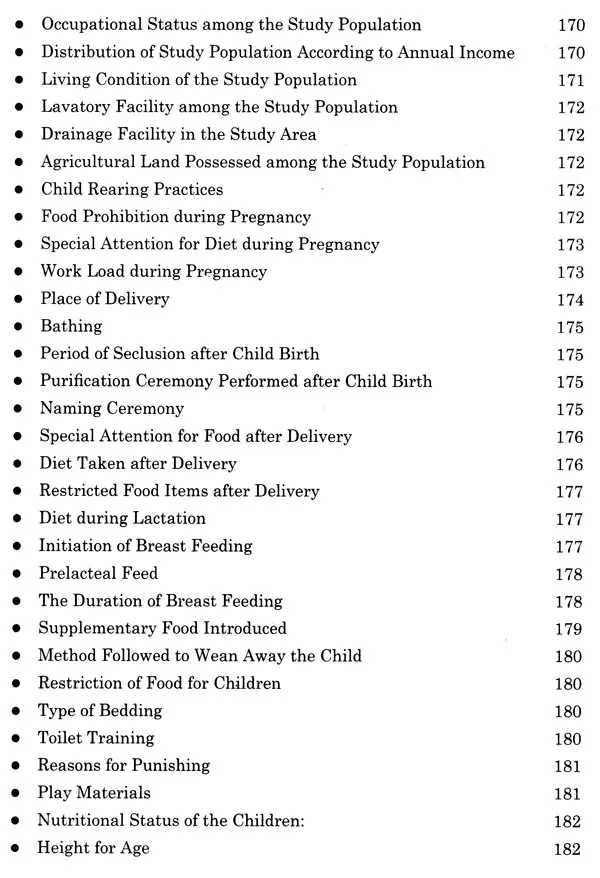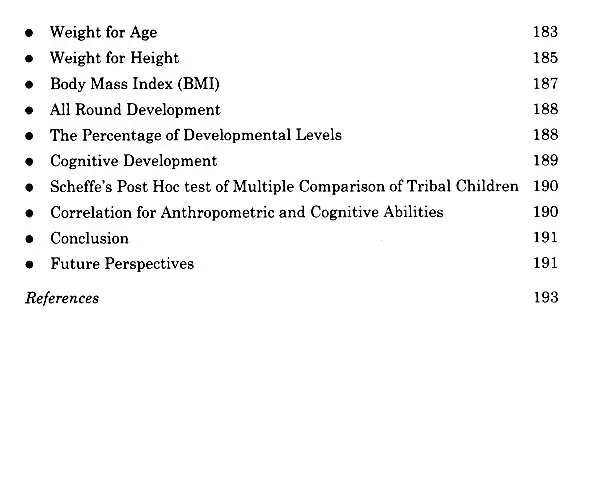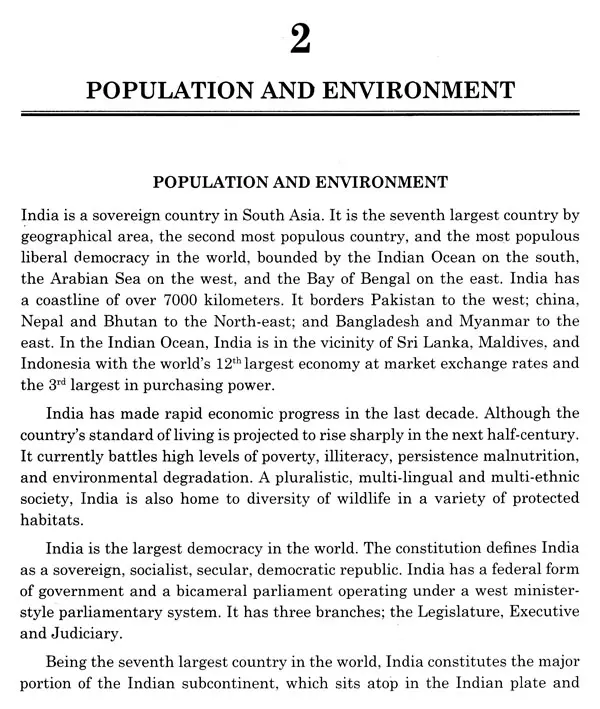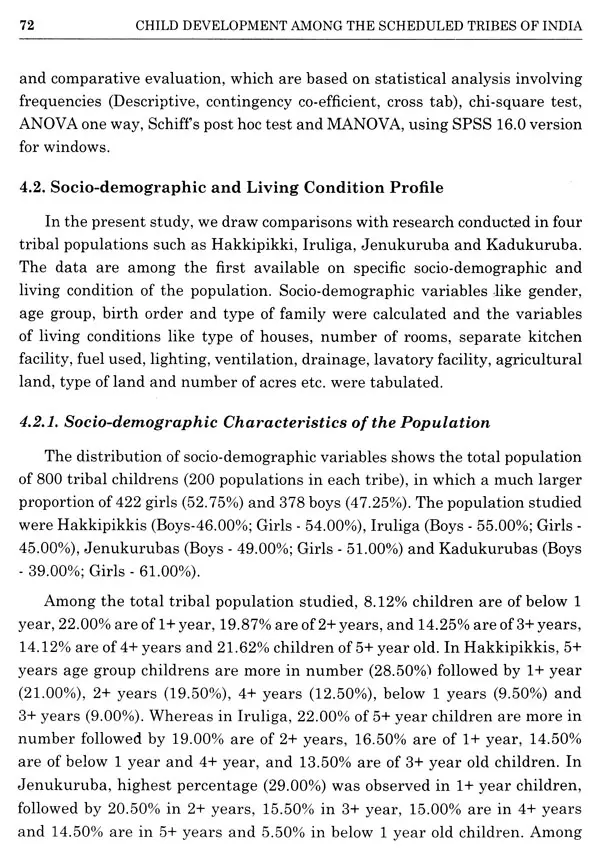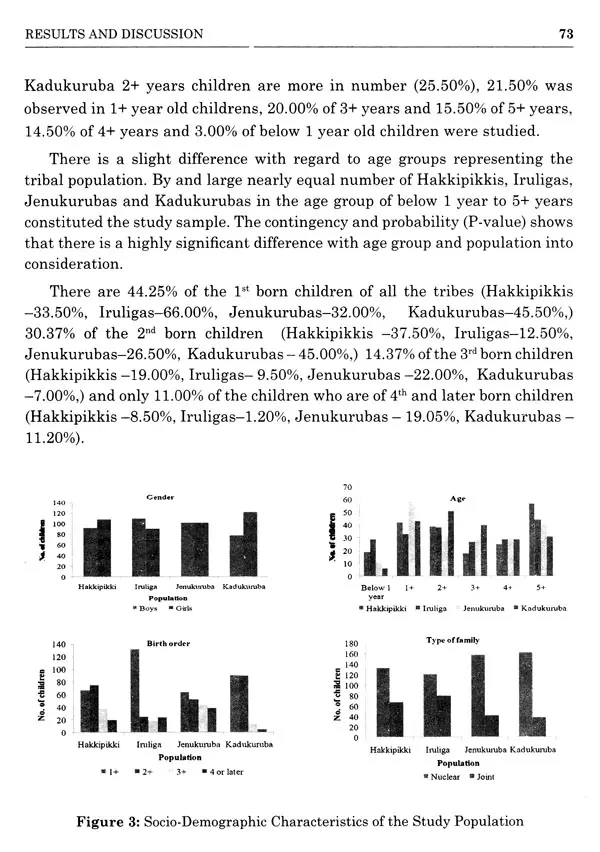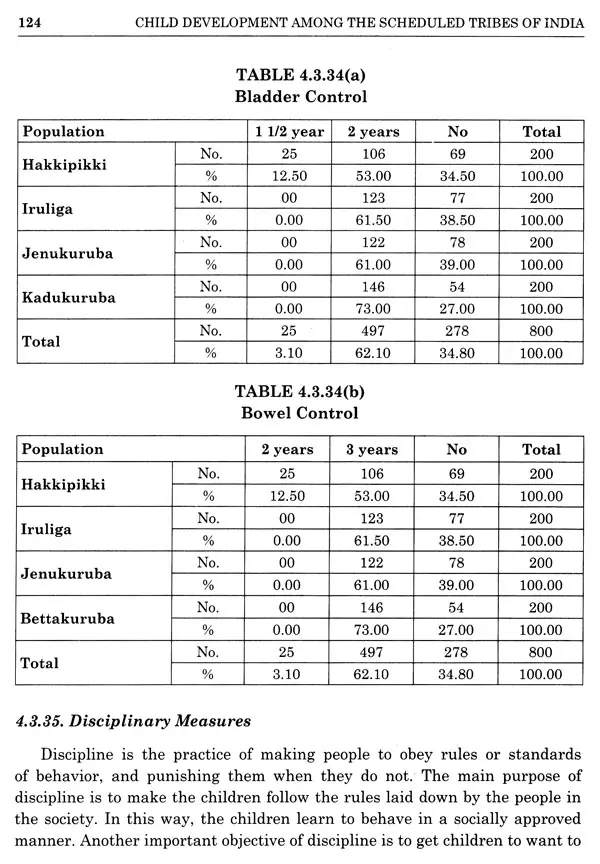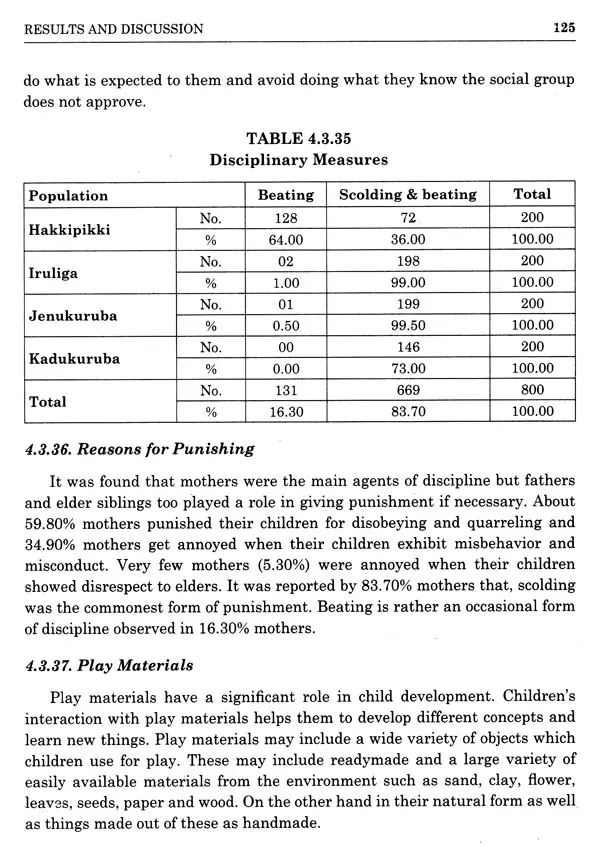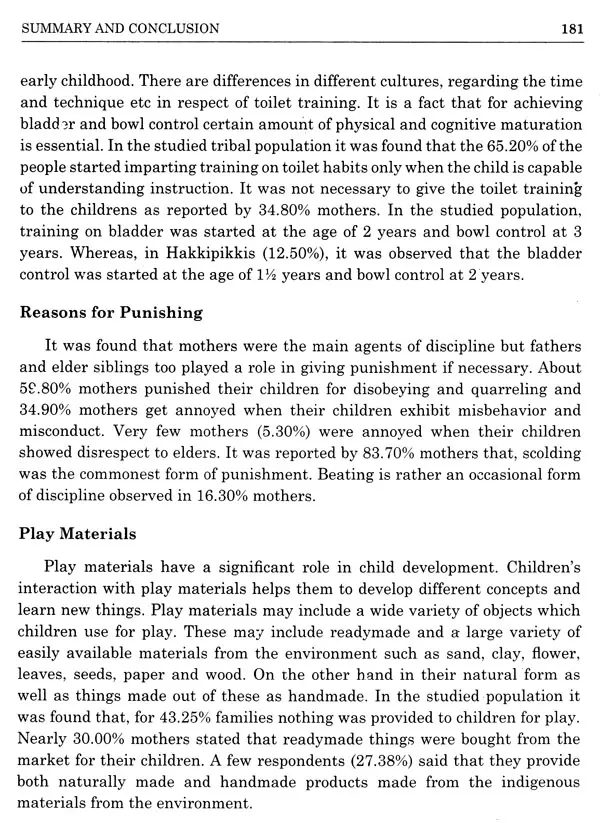
Child Development Among The Scheduled Tribes of India
Book Specification
| Item Code: | UAP427 |
| Author: | B. Dakshayani & M.R Gangadhar |
| Publisher: | Aayu Publications, New Delhi |
| Language: | English |
| Edition: | 2016 |
| ISBN: | 9789385161179 |
| Pages: | 216 |
| Cover: | HARDCOVER |
| Other Details | 10.00 X 7.50 inch |
| Weight | 580 gm |
Book Description
This book attempt to fill the gap by explores the child-rearing practices and developmental status of children in (0 to 6 years of age group) selected tribal population of Mysore district, Kamataka. The book cognizance of the socio-demographic and living condition of the children, which influenced on the child rearing practices, physical, motor, cognitive, emotional, language. personal social and body measurement of children. The book develops five major themes 1. The bellef, customs, rituals associated with pregnancy, lactation and child rearing. 2. The belief and practices associated with feeding of children. 3. The belief and practices associated with personal hygiene and health care of children. 4. The customs and role of parents in socialization of children. 5. The level of development under different faculties like, physical, motor, cognitive, emotional, language and personal social. The book will be useful for planners and policy makers of government setup, scholars and researchers in the field anthropology and child development.
Dr. B. Dakshayani, obtained M.Sc. and Ph.D. Degree in Anthropology from University of Mysore, Mysore. Dr. Dakshayani was a UGC, Research Fellow She has published over twenty research papers in National and International peer reviewed Journals. She has participated and presented research papers in national seminars and conferences. She has served as a Project Assistant in ICMR. Project. JSS Medical College, JSS University, Mysore in Karnataka State.
Dr. M.R. Gangadhar is Professor in the Department of Anthropology, University of Mysore, Mysore. Since 1997 he is teaching Biological Anthropology in the University of Mysore. Dr. M.R. Gangadhar has completed eight major research projects which were financed by University Grants Commission, Indian Council of Medical Research, Ministry of Human Resource Development, New Delhi and Government of Karnataka. He has done extensive field work and research work in tribal areas of Karnataka. He has published over Ninety Five research articles in journal of National and International repute. He is the Author of one book and co-author of three books. He has participated and presented more than fifty research papers in National and International seminars/ Conferences. He has Chaired several session of the National and International seminar/Conferences. He is a successful guide of seven Ph.D. candidates. He has organised one session in International Conference, International Union of Anthropological and Ethnological Sciences-2013, Manchester University, UK. He is an editorial board Member for few Journals.
Children are the world's greatest and most precious resource. They are the important human resource for any nation. The future of the country depends on its children. The process of bringing up a child plays a vital role in society. It is the foundation on which the personality of a child and its future depends. Development refers to a progress, which brings about bodily and physiological changes internal as well as external in an organism from conception till death. The child's physical development has a marked influence on the quality and quantity of its behaviour. Physical development is the most obvious aspect of development and has important bearing on the children's total development. Child rearing may be considered to include the overall care, socialization and training of the growing child in a particular culture. The child-rearing practices are not the same everywhere. Each culture, subculture or ethnic group has its own values and ideals; a distinctive way of life and hence, the practices of child rearing tend to differ from one culture to another. Even, with in the same social and cultural setting there might be differences according to economic condition of families, level of literacy and also on the basis of values and attitudes of the parents, cultural and social factors such as food habits, beliefs, superstitions play a major role in determining child rearing practices. India has a rich assembly of cultures. Among its diverse populations, the tribal communities keep on perpetuating certain distinctive cultural traits. They have a variety of customs and traditions, each distinct from the others. The present study is an attempt to fill this gap by exploring the child-rearing practices and developmental status of children (0 to 6 years of age group) in selected tribal population of Mysore district, Karnataka.. First chapter presents the salient features of the study, a brief survey of the notable works done on various aspects of Child development in India and objectives of the study. Study Population and Environment are presented in the second chapter under different headings. The third chapter enumerates the selection and distribution of the sample, methods of study, research tools and statistical analysis. Socio- Demographic and Living Condition Profile, Child Rearing Practices, Nutritional Status of the children, All round development and Cognitive Development are detailed in Fourth chapter. The fifth chapter contains the summary and conclusion of the study. A reference is appended at the end. This book will be useful for researchers, planners and policy makers of government setup.
Anthropology is considered as the holistic study of mankind. Physical/Biological Anthropology one of the branches of Anthropology puts emphasis on biological aspects including human health, nutrition, growth, development etc. It also studies fertility, mortality and morbidity aspects of different populations.
Child rearing practices are also considered as an important component of human bio-cultural behavior. Child's physical health throws much light on the quality of its behavior. Hence, it is very essential to take care of the child's health in our society, since they are often described as the wealth of the nation. Child care practices often depend upon the interaction between the individuals and cultural behavior of a particular society concerned.
Since beginning social scientists have shown lot of interest in knowing the fact of child rearing practices in different communities. Child-mother relationship not only helps to shape the behavior of the child, but also to strengthen the ties between two. Childhood experiences definitely help the child to develop special skills to combat problems in later part of the life. Therefore, in this context mother's role is most important which influences the growth and development of the children to a great extent.
India is a land of diverse cultures. Child development and child rearing practices in different communities depend on economic and social-cultural aspects such as food habits, beliefs and superstitions. At the same time people in the society are bound by some norms and values. Certain child rearing practices are unique that they are used to protect the children from diseases, dangers and other possible threats. In broader perspective child care practices differ from community to community.
Anthropology is the study of humankind. Of all the disciplines that examine. aspects of human existence and accomplishments, only Anthropology explores the entire panorama of the human experience from human origins to contemporary forms of culture and social life. A hallmark of Anthropology is its holistic perspective understanding humankind in terms of the dynamic interrelationships of all aspects of human existence. Biological anthropologists are concerned with the physical and biocultural aspects of humans, including biological aspects of human health and well being: micro and macro evolutionary: study of the human condition; relationships to other primates; human growth and development; pathology, mortality and morbidity; and population genetics.
Children are the world's greatest and most precious resource. They are the important human resource for any nation. The future of the country depends on its children. A society's civilization is measured on how it protects and cares for its children. The process of bringing up a child plays a vital role in society. It is the foundation on which the personality of a child and its future depends. The quality of human resource of any country is largely determined by the quality of its child development, which in turn is a reflection of health and nutritional status.
Development refers to a progress, which brings about bodily and physiological changes internal as well as external in an organism from conception till death. The child's physical development has a marked influence on the quality and quantity of its behaviour. Physical development is the most obvious aspect of development and has important bearing on the children's total development.
Book's Contents and Sample Pages
